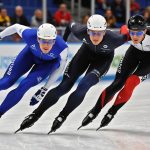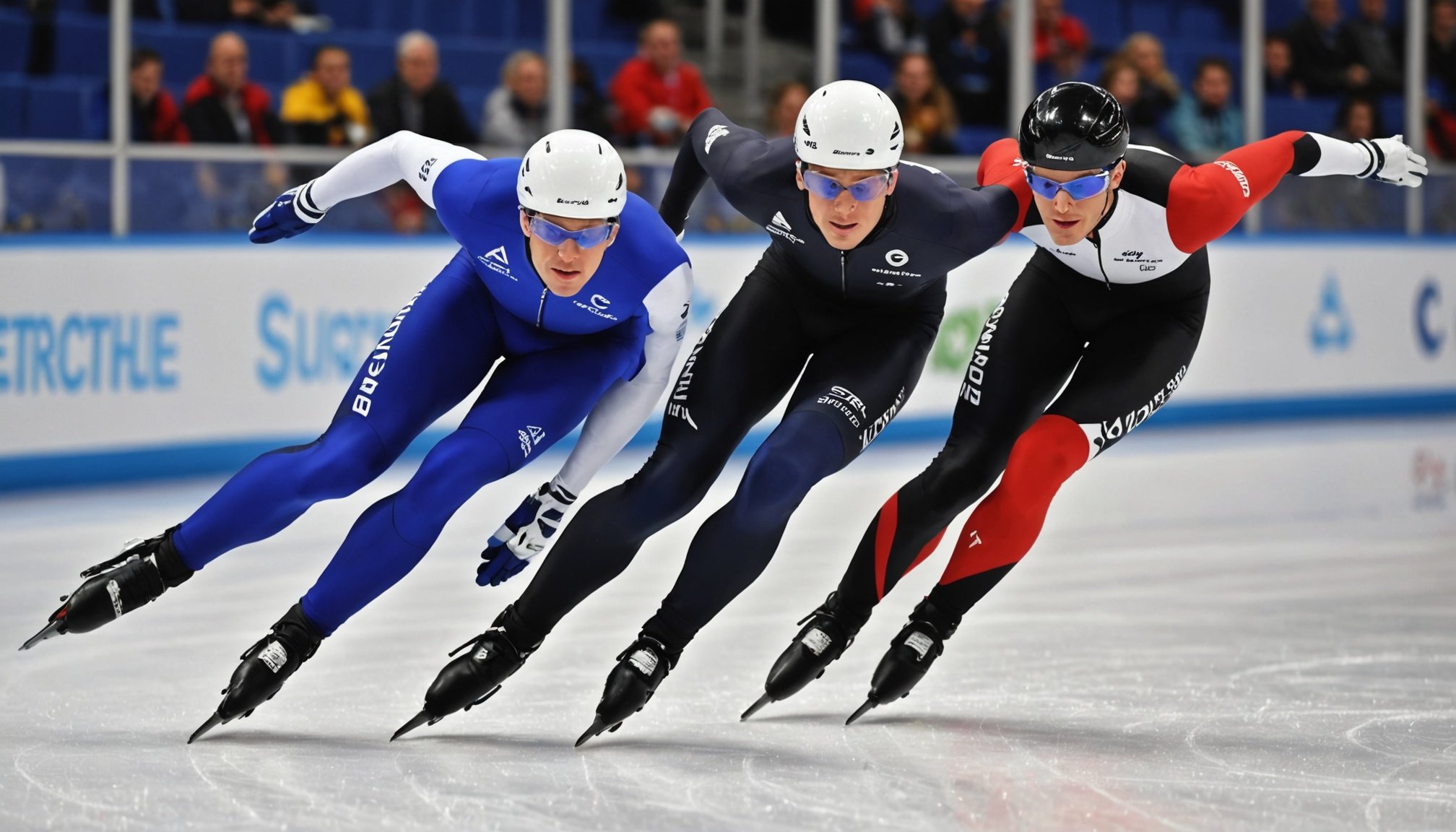Understanding Aerodynamic Drag in Speed Skating
Aerodynamic drag plays a pivotal role in speed skating performance, dictating how efficiently a skater glides on ice. At its core, aerodynamic drag refers to the resistance a skater encounters due to air friction. As skaters aim for optimal speed, reducing this drag becomes essential. The relevance of aerodynamic drag in speed skating cannot be overstated; it directly impacts both speed and energy consumption.
Several factors affect aerodynamic drag, notably the skater’s body position. For instance, a streamlined position with a low tuck minimizes drag by reducing the exposed surface area. In contrast, more upright stances increase drag, hindering speed. The physics of drag illustrates that even marginal adjustments in posture can significantly alter a skater’s velocity over a race.
Additional reading : Unleashing Your Potential: Mastering Off-Season Training Strategies for Competitive Cyclists”
Drag influences race outcomes by affecting speed and endurance. Skaters with better aerodynamic efficiency can maintain higher speeds with less energy expenditure. This advantage becomes crucial in competitive settings, where milliseconds determine podium finishes. Understanding these principles allows skaters to optimize their strategies and gear towards minimizing aerodynamic drag and enhancing overall performance. Achieving this balance of physics and technique underscores the importance of mastering drag reduction in speed skating.
Measurement Techniques for Aerodynamic Drag
In the quest to achieve optimal skating performance, understanding drag measurement techniques is crucial. Traditional methods primarily rely on wind tunnels, where wind speeds and directions are controlled to evaluate how skaters interact with airflow. This instrumentation allows for precise analysis of aerodynamic characteristics by simulating realistic conditions.
Also read : Optimizing Recovery Strategies: Essential Post-Competition Protocols for Ultra-Endurance Athletes
Wind tunnels play a pivotal role in examining skater performance as they offer a controlled environment to measure aerodynamic drag. By adjusting the position, speed, and posture of a skater within a wind tunnel, engineers can ascertain how these factors influence drag measurement.
Emerging technologies provide innovative solutions for real-time drag evaluation in competitive environments. Modern techniques utilize on-site instrumentation, such as wearable sensors, which monitor and analyze drag as athletes perform. This advancement offers instantaneous feedback, enabling skaters to make adjustments mid-competition and optimize their performance.
Instruments like laser Doppler anemometry and particle image velocimetry allow for detailed analysis of airflow patterns around a moving skater. By implementing these techniques, researchers can visualize and quantify how air interacts with the body in real-time, thus refining drag measurement processes and enhancing performance assessment methodologies.
Mathematical Models for Analyzing Drag
Understanding aerodynamic drag fundamentally requires a keen insight into mathematical modeling. At the core of this analysis, the drag equation plays a pivotal role. It helps simulate the resistive forces acting on objects in motion through a fluid. The equation itself, a well-established formula in physics, is derived from principles pertaining to both kinetic energy and fluid dynamics – illustrating the relationship between velocity, drag coefficient, fluid density, and frontal area.
Computational Fluid Dynamics (CFD) elevates the application of these principles by using numerical analysis and data structures to solve and analyze problems involving fluid flows. Through CFD, engineers can simulate the interaction of liquids and gases with surfaces, providing a comprehensive understanding of drag forces without the need for wind tunnel experiments. This revolutionary approach allows for precision and efficiency when optimizing designs.
Grooved within practical application, various case studies confirm the robustness of these mathematical models. For example, in real racing scenarios, CFD has been employed to fine-tune the aerodynamics of racing cars, reducing drag and enhancing performance. These studies verify the utility and practical benefits of using mathematical models to predict and mitigate drag effectively.
Equipment Influence on Aerodynamic Performance
Understanding gear optimization in speed skating is crucial for achieving peak performance enhancement. The selection and configuration of equipment, particularly skates and suits, significantly impact aerodynamic drag, affecting speed and efficiency on the ice.
Skates and Suits
Different types of skates and suits are engineered to minimize drag by optimizing their shapes and materials. Skates designed with a low-cut design and polished surfaces reduce air resistance, enhancing speed. Similarly, speed skating suits are crafted from lightweight, smooth fabrics to aid in aerodynamic performance by ensuring minimal air disruption during movement.
Helmets and Their Design
Beyond suits and skates, helmets play a pivotal role. The design and positioning of helmets are vital for cutting down on drag. Streamlined helmets guide airflow smoothly over the skater’s body, leading to reduced turbulence and increased performance enhancement.
Equipment Regulations
Performance optimization must adhere to stringent equipment regulations set by governing bodies. These regulations ensure fair competition by standardizing equipment while allowing room for innovation that optimizes for speed without compromising safety. Understanding these rules is pivotal for competitors aiming for top-tier speed skating achievements.
In the world of speed skating, every piece of gear can be the difference between winning and losing, underlining the necessity for thorough gear optimization.
Body Positioning and Technique
Understanding body mechanics is crucial in enhancing performance in competitive skating. Minimizing drag reduction plays a pivotal role in ensuring that a skater maintains speed and efficiency. Effective skating techniques involve optimizing how one’s body interacts with the air. Maintaining a low, streamlined posture notably decreases drag. This means bending slightly at the knees, aligning the back horizontally, and keeping arms close to the body.
Incorporating technique adjustments significantly influences one’s aerodynamic efficiency. Proper body positioning reduces air resistance and controls how energy is expended during races. By leaning slightly forward and maintaining a steady center of gravity, skaters can achieve a smoother trajectory.
Throughout the history of competitive skating, several elite athletes have showcased ingenious adaptations to their techniques. For example, certain skaters have mastered the art of maintaining consistent speed by adjusting their body angle on curves. This allows them to conserve energy and optimize their performance.
In conclusion, understanding and employing the right body mechanics through strategic skating techniques and focusing on drag reduction not only enhances speed but also sustains endurance in races. This makes the difference between merely racing and racing efficiently.
Environmental Factors Affecting Aerodynamics
Understanding environmental impact is crucial for optimising speed skating performance. Weather conditions such as temperature and humidity directly affect aerodynamics. Higher temperatures typically thin the air, reducing air resistance and thus drag. Conversely, cold conditions can increase air density, impacting the skater’s speed. In high humidity environments, air becomes denser, potentially increasing resistance and altering drag outcomes notably.
Altitude effects play a significant role, as well. At higher altitudes, air density decreases, potentially reducing drag and allowing faster skating speeds. However, athletes must adapt their breathing strategies due to lower oxygen levels, influencing overall performance.
Race strategies must account for these environmental conditions to achieve peak performance. Skaters often adjust their techniques based on temperature fluctuations, humidity levels, and altitude considerations. For example, in warmer, high-altitude races, athletes may employ techniques to conserve energy due to reduced air resistance, enabling sustained speed over distance.
Key considerations for coaches and skaters include continuously monitoring the weather forecast and utilising simulations to practice under varied environmental conditions. By strategically integrating these insights, skaters can enhance their performance despite environmental challenges, ensuring optimal results during competition.
Practical Applications: Training and Competition
In the realm of training strategies and competitive preparation, understanding the nuances of aerodynamic drag can propel athletes to new heights. Implementing effective training methodologies is crucial for reducing drag during performance. Athletes often employ wind tunnel testing and computational simulations to refine their stances and equipment choices. These methodologies provide immediate feedback on how positioning affects airflow, enabling tailored adjustments.
During competitions, athletes can maximise their performance by incorporating aerodynamic considerations into their performance tactics. For instance, cyclists can optimise their posture to minimise frontal area exposure, thereby reducing resistance. Meanwhile, swimmers experiment with various body angles and streamline techniques to cut down water drag.
Feedback and analysis play a pivotal role in the ongoing enhancement of athlete performance. Advanced tools such as video analysis and force-sensing technology give insights into real-time aerodynamic efficiency. By consistently applying these insights, athletes can iterate new techniques and refine their competition strategies. This constant feedback loop ensures that any new innovations or strategies remain grounded in practicality and effectiveness.
By focusing on these practical applications, athletes not only improve individual performance but also gain a competitive edge, transforming theoretical knowledge into real-world success.













